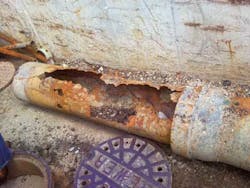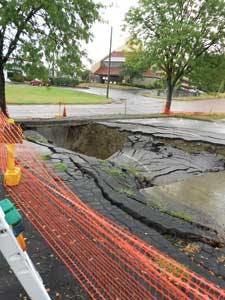Calculating the Costs: Utilities Highlight Need for Rate Hikes, Investment in Infrastructure Development
By Art Haddaway, WaterWorld Editor
Undeniably¸ water and wastewater utilities today require a great deal of funding in order to function effectively. As such, facilities are regularly compelled to raise their rates to cover the increasing costs of providing the best services possible for their customers and communities.
There are a number of factors that determine the need for rate hikes among utilities, but none more than aging infrastructure. Particularly within the last 20 years, the expense of maintaining water and wastewater infrastructure has surged dramatically across the industry given the need to upgrade systems built in earlier periods of the 20th century that are now simultaneously reaching the end of their life expectancies.
"There is a very significant need to increase the investment in water and wastewater infrastructures because the systems that we rely on are very largely bought and paid for by earlier generations, and they're coming to the very end of their useful service lives," said Tom Curtis, deputy executive director for the American Water Works Association (AWWA).
George Hawkins, general manager for DC Water, added, "The bulk of it (infrastructure) was installed around the same 10 to 20 year timeframe, and there weren't a lot of replacement funds built into the budgets because it was new for a long time. That era has gone by, and we're really at the point where significant infrastructure needs to be rehabilitated and replaced, not just maintained."
Rate hikes differ with each municipality based on varying locations, infrastructure history and regulations, but most cities across the nation have seen consistent and similar growth overall. Hawkins, for example, explained that DC Water's Blue Plain's facility invested $25 million in an upgrade to its infrastructure in the late 1970s and is just now completing another renovation estimated at $1 billion.
"Since 2009, our rates have doubled," said Hawkins. "Overall, it will be up about 60 percent since I've come on board (in 2009). Given the work that's needed and the fundamental nature of the services we deliver, there's no question that these rates are worth paying."
For Sanitation District No. 1 in Northern Kentucky, the district's rate structure has fluctuated over the years. "I have parts of my service area that were built in the late 1800s and early 1900s and other parts built in the 1980s and 1990s, so I have a very diverse system," said David Rager, executive director. "We've been raising rates over a period of about 10 years now, some at 10 percent and others at 15, with a couple of 20s."
The city of Los Angeles Sanitation Department has also experienced noticeable changes in their rate patterns. Assistant General Manager for Sanitation Adel Hagekhalil mentioned, "We did a 10-year rate increase in LA. What is the value? It puts stability in the system. We are improving infrastructure, reducing sewer spills, providing higher quality water, and preventing high-cost emergencies for businesses and communities."
One of the major challenges utilities potentially face in upgrading their infrastructure, however, is the lack of capital required to wholly integrate change whilst striving to comply with federal and state mandates. The water and wastewater industry heavily relies on state revolving funds (SRFs) to support their engineering needs. Yet, governmental expenditures to supplement development have diminished, largely as a result of a downturned economy and revised and fluctuating regulation policies.
"That money is getting hit hard trying to balance the federal budget, and the states are not able to put any money into that fund; that's happening across the country," said Rager. "For utilities, low-cost borrowing money is starting to dry up, and they're going to start relying on the municipal or revenue bond market to finance infrastructure projects - rates will have to go up."
As such, when it comes to footing the bill in today's market, utilities are more so tending to seek the support of their local communities. It's becoming imperative that they receive this public backing in light of these funding trends and adopt an effective strategy that can best accommodate both the facilities and their customers. The regulatory activity of pricing and enacting rates, or ratemaking, is an integral component to the operation of many utilities. Further, it seeks to establish the lowest potential costs for consumers while ensuring the monetary stability of water plants.
Deciding on the appropriate ratemaking approach and then implementing it, however, can be a daunting task, especially when the demand for subsidies is so high and the public's understanding of why rate hikes are needed is questionable. Adequate water and wastewater infrastructure is critical to the welfare of communities, and utilities are challenged to continually convey the value of these systems to the public in order to gain their full cooperation.
But how do utilities earn this trust and apply it toward a program that works? Every plant is different, and consequently there are varying methods for establishing a good rapport with the pubic and incorporating a successful ratemaking program. In general, however, it's essential that utilities make it a priority to educate and engage with their communities.
Clear communication between utilities and their consumers about the worth of water and what's involved in the ratemaking process can certainly be a resourceful tool. "Customers who understand why the utility needs to raise rates and how they're being raised are more likely to be comfortable and satisfied with the bill simply because they understand it," said Curtis. "That entails going out into the community and having meetings and face to face conversations."
Hagekhalil added that the key for utilities is to interact with their customers long before ever increasing their rates. Further, it's important that facilities explain why infrastructure is important, what challenges they're facing and how they're overcoming them, and what they're planning for the future in terms of continuing to sustain their localities.
While most communities rely heavily on drinking water and wastewater services, the public is largely unaware of the costs and labor devoted to maintaining the infrastructure necessary to provide those amenities, partially because the majority of municipal water infrastructure is built underground.
"How can we make the investment and the value of investment visible to residents and ratepayers?" said Hagekhalil. "Utilities have to open their doors and be transparent and engage the businesses and public in the process of understanding what we're dealing with, the issues we are we're facing, and making the invisible visible."
Hawkins further explained that the largest effort in his utility's ratemaking process has been in external affairs. "It's the core of the business," he said. "That notion of communicating with customers is job number one because it's the premise upon which the whole structure is built. We want people to understand that these are the best and most efficient dollars that they spend among the issues that they spend money for."
The NAWC highlights in its report that without the proper investment in water and wastewater infrastructure, a number of important facets contributing to the overall welfare of the water industry could be severely threatened. "Insufficient infrastructure investment can lead to the possible future degradation of drinking water and ecosystems, as well as inefficient operation of systems, greater water loss and higher cost," the study showed.
Rager added, "The bottom line is you have to provide the service and replace infrastructure somehow. If your low-cost sources of funding dry up, you have to turn to the higher-cost source - that has to be paid for."
Curtis also remarked, "In many cases, rates simply must continue to increase. If you can't raise rates to meet operating expenses, you can't survive as a viable strong utility service."
Accordingly, many customers are willing to invest in high-quality water and wastewater services as long as they have the opportunity to understand the process, share their concerns and contribute to future development. Moving forward, rate increases will continue to be a necessity as utilities comply with regulations. But by managing their assets, engaging the public and investing in low-impact development, utilities will be poised to gain and preserve the trust and understanding of the public and their local communities. WW Circle No. 248 on Reader Service Card






